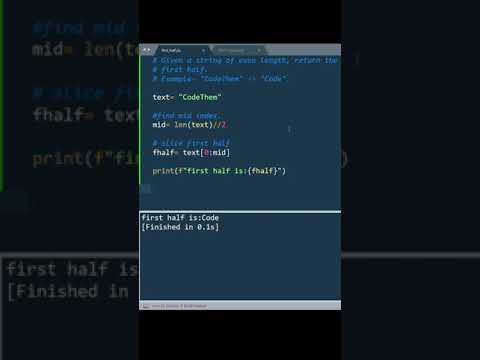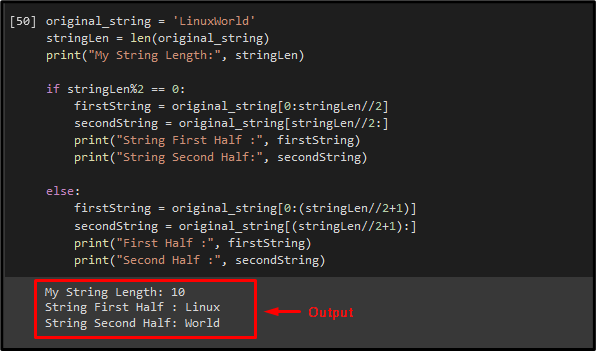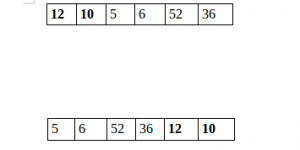Split String In Half Python
Defining the Problem
When we talk about splitting a string in half, we are referring to dividing a given string into two equal parts. The concept of splitting a string in half can be interpreted differently based on the length of the string. If the length of the string is even, splitting it in half means dividing it into two equal parts. However, if the length is odd, splitting in half involves dividing the string into two parts where the first part has one less character than the second part.
Using String Slicing
String slicing is a powerful feature in Python that allows us to extract portions of a string based on their indices. The basic syntax of string slicing is `string[start:end:step]`, where `start` is the starting index, `end` is the ending index (exclusive), and `step` specifies the increment between indices. To split a string in half using string slicing, we need to determine the appropriate indices.
Let’s consider an example where the input string is “Hello, World!”. If the length of the string is even (12 in this case), we can simply use string slicing with `end` set to half the length of the string:
“`python
string = “Hello, World!”
half_length = len(string) // 2
first_half = string[:half_length]
second_half = string[half_length:]
“`
In this example, `first_half` will be “Hello, ” and `second_half` will be “World!”.
However, if the length of the string is odd (13 in this case), we need to adjust the indices slightly. We can set `end` to `half_length + 1` to include the additional character in the first half:
“`python
string = “Hello, World!”
half_length = len(string) // 2
first_half = string[:half_length + 1]
second_half = string[half_length + 1:]
“`
In this case, `first_half` will be “Hello, W” and `second_half` will be “orld!”.
Utilizing the len() Function
The len() function in Python returns the length of a given string. It is a handy tool when splitting a string in half because it allows us to dynamically determine the appropriate indices for string slicing.
Using the len() function, we can split a string in half by following these steps:
1. Get the length of the string using `len(string)`.
2. Calculate the half length by dividing the length by 2 using integer division (`//`). This will give us the index that splits the string in half (for even lengths) or slightly towards the first half (for odd lengths).
3. Use string slicing with appropriate indices to separate the string into two halves.
Here is an example:
“`python
string = “Hello, World!”
half_length = len(string) // 2
first_half = string[:half_length]
second_half = string[half_length:]
print(first_half) # Output: “Hello, ”
print(second_half) # Output: “World!”
“`
In this case, the output will be the same as before, with `first_half` containing “Hello, ” and `second_half` containing “World!”.
Implementing the Splitting Algorithm
To implement an algorithm for splitting a string in half, we can follow these steps:
1. Get the length of the string using `len(string)`.
2. Check if the length is even or odd.
3. For even lengths, divide the length by 2 to get the half length.
4. For odd lengths, calculate the half length by using `length // 2` and adding 1 to it.
5. Use string slicing with appropriate indices to separate the string into two halves.
Here is an example implementation:
“`python
def split_string(string):
length = len(string)
if length % 2 == 0:
half_length = length // 2
else:
half_length = (length // 2) + 1
first_half = string[:half_length]
second_half = string[half_length:]
return first_half, second_half
string = “Hello, World!”
first_half, second_half = split_string(string)
print(first_half) # Output: “Hello, ”
print(second_half) # Output: “World!”
“`
Handling Special Cases
When dealing with edge cases, such as extremely short strings or empty strings, we need to consider specific scenarios to ensure the splitting works correctly.
For extremely short strings, where the length is less than or equal to 1, splitting them in half might not be meaningful. In such cases, it is up to the programmer to decide on the desired behavior. It could involve returning the original string as the first half and an empty string as the second half, or any other custom logic.
For empty strings, where the length is 0, splitting is straightforward. Both halves will be empty strings.
Exploring Alternative Approaches
While string slicing is a simple and efficient method for splitting a string in half, there are alternative approaches worth exploring. One alternative is to use regular expressions to split the string based on a specified pattern. Python’s `re` module provides powerful regex functionalities that can be utilized for this purpose.
Another alternative is to use libraries or modules specifically designed for string manipulation. Examples include the `textwrap` module, which provides advanced text formatting tools, or the `split-string` package, which offers additional splitting options.
Working with Unicode and Multibyte Characters
When dealing with Unicode characters and multibyte encodings, splitting a string in half requires additional considerations. Since characters in such encodings can have variable byte lengths, blindly splitting the string might result in invalid characters or unexpected behavior.
To handle Unicode characters and multibyte encodings, it is recommended to use Unicode-aware string manipulation methods, such as those provided by the `unicodedata` module. These methods can correctly handle splitting while preserving the integrity of the characters.
Handling Exceptional Characters or Substrings
In certain scenarios, the input string may contain exceptional characters or substrings that could impact the splitting process. For example, if the string contains a delimiter character that is used to split text into sections, splitting based on that delimiter might lead to incorrect results.
In such cases, it is important to address these exceptional characters or substrings before performing the splitting operation. This can be achieved by either removing or escaping those elements, depending on the specific requirements.
Testing and Validating the Solution
To ensure the correctness and robustness of the splitting implementation, we need to devise a set of test cases that cover different scenarios. It is important to test corner cases, limit cases, and normal cases to validate the solution thoroughly.
For example, we can test with various input strings of different lengths to verify that the splitting algorithm works correctly for both even and odd lengths. We can also test with special characters or substrings to ensure the solution handles them appropriately.
FAQs
Q: Can I split a string into more than two halves?
A: The splitting algorithm discussed in this article focuses on dividing a string into two halves. However, if you desire to split the string into more than two parts, you can modify the algorithm accordingly. For example, you can determine the number of parts you want and evenly divide the string based on that number.
Q: Can the splitting algorithm handle non-ASCII characters?
A: Yes, the splitting algorithm can handle non-ASCII characters, including Unicode characters and multibyte encodings. By using appropriate string manipulation methods, such as those provided by the `unicodedata` module, you can ensure the splitting works correctly for such characters.
Q: Does string slicing modify the original string?
A: No, string slicing does not modify the original string. It returns a new string that contains the sliced portion. The original string remains unchanged.
Q: Can I split a string only from the second half onwards?
A: Yes, by utilizing string slicing, you can specify the starting index to split the string from the second half onwards. For example, you can use `string[half_length:]` to obtain the second half of the string.
Q: Is there a performance difference between using string slicing and other splitting methods?
A: String slicing is generally a very efficient method for splitting a string in Python since it operates on the string’s underlying memory without creating new copies. However, depending on the specific requirements and the size of the input string, alternative methods, such as using regular expressions or libraries, might offer different trade-offs between performance and readability. It is recommended to benchmark different approaches to determine the most suitable one for your use case.
In conclusion, splitting a string in half in Python can be achieved through string slicing, utilizing the len() function, and applying an appropriate splitting algorithm. It is essential to handle special cases, explore alternative approaches, and consider Unicode and multibyte encodings. By testing and validating the solution with various scenarios, we can ensure its correctness and robustness.
Find First Half Of A String In Python
Keywords searched by users: split string in half python split string in half javascript, Split string into 2 parts python, split string in half c++, how to print the second half of a string in python, python split string, split python, Python Split string by length, string 2 python
Categories: Top 14 Split String In Half Python
See more here: nhanvietluanvan.com
Split String In Half Javascript
JavaScript is a versatile programming language that allows us to manipulate and handle strings with ease. One common task when working with strings is to split them into smaller parts for further analysis or processing. In this article, we will explore various methods to split a string in half using JavaScript, providing in-depth insights and examples to help you understand the concepts thoroughly.
Before we dive into the different techniques, let’s first understand what splitting a string in half means. Splitting a string in half refers to dividing the given string into two equal halves, ensuring that both halves have an equal number of characters. This can be particularly useful when working with data that requires equal distribution or when you need to perform operations on two separate parts of the string independently.
Method 1: Using the slice() function
The slice() function is a built-in JavaScript method that allows us to extract a portion of a string based on its indices. By utilizing the slice() function, we can easily split a string in half. Here’s how it can be done:
“`javascript
let str = “Hello, World!”;
let length = str.length;
let firstHalf = str.slice(0, length / 2);
let secondHalf = str.slice(length / 2);
console.log(“First half: “, firstHalf);
console.log(“Second half: “, secondHalf);
“`
In this example, we declare a string variable `str` with the value “Hello, World!”. Next, we calculate the length of the string with `length = str.length`. We then use the slice() function to split the string into two halves. The first half is obtained by using `str.slice(0, length / 2)`, and the second half by using `str.slice(length / 2)`.
Method 2: Using the substring() function
Similar to the slice() function, the substring() function also allows us to extract a region of a string based on indices. To split a string in half using substring(), we can utilize the following code:
“`javascript
let str = “Hello, World!”;
let length = str.length;
let middleIndex = length / 2;
let firstHalf = str.substring(0, middleIndex);
let secondHalf = str.substring(middleIndex);
console.log(“First half: “, firstHalf);
console.log(“Second half: “, secondHalf);
“`
Here, we assign the string “Hello, World!” to the variable `str` and calculate its length. In the next step, we define `middleIndex` as `length / 2`. By using `str.substring(0, middleIndex)`, we obtain the first half of the string, and with `str.substring(middleIndex)`, we get the second half.
Method 3: Using the substr() function
The substr() function in JavaScript is another method that can be used to split a string in half. It takes a starting index and a length parameter to define the section of the string to extract. To split a string, we can apply the following approach:
“`javascript
let str = “Hello, World!”;
let length = str.length;
let halfLength = Math.floor(length / 2);
let firstHalf = str.substr(0, halfLength);
let secondHalf = str.substr(halfLength);
console.log(“First half: “, firstHalf);
console.log(“Second half: “, secondHalf);
“`
In this example, we assign the string “Hello, World!” to `str` and calculate its length. The `halfLength` variable is determined by dividing `length` by 2 and then flooring the result. By applying `str.substr(0, halfLength)`, we obtain the first half of the string, while `str.substr(halfLength)` returns the second half.
Method 4: Using regular expressions
JavaScript also supports regular expressions, which offer a powerful way to manipulate strings. We can leverage regular expressions to split a string in half by matching and extracting the desired portions. Here is an example:
“`javascript
let str = “Hello, World!”;
let length = str.length;
let regex = /^(.{1,}?).*\1$/;
let halves = regex.exec(str);
let firstHalf = halves[1];
let secondHalf = str.replace(firstHalf, ”);
console.log(“First half: “, firstHalf);
console.log(“Second half: “, secondHalf);
“`
In this illustration, we declare `str` as our target string and compute its length. Next, we define a regular expression `regex` using the pattern “/^(.{1,}?).*\1$/” that will match any string with exactly two equal halves. We use the `exec()` function to obtain the halves array, and then extract the first half with `halves[1]`. Finally, we use `str.replace(firstHalf, ”)` to obtain the second half.
FAQs:
Q1. Can I split a string into more than two equal halves?
A1. The methods described in this article split a string into two equal halves. However, by modifying the code slightly, you can split the string into more equal parts. For example, using the slice() method, you can divide the string into three or more equal parts by adjusting the start and end indices accordingly.
Q2. What if the string has an odd number of characters?
A2. If the string has an odd number of characters, splitting it into two equal halves using the methods discussed above will not be possible. The resulting halves may differ in length by one character.
Q3. Are there any performance implications of these methods?
A3. In terms of performance, the slice(), substring(), and substr() methods have similar results, as they internally handle the string operations efficiently. However, using regular expressions (as shown in Method 4) can have a slight performance impact, especially when dealing with large strings or when executed frequently.
Q4. Can I split a string in half based on a specific delimiter?
A4. Yes, you can split a string in half based on a specific delimiter using JavaScript’s split() method. By defining the delimiter, you can separate the string into two parts, similar to the examples provided above. However, the split will not guarantee equal lengths for both halves if the delimiter is not symmetrically placed.
In conclusion, splitting a string in half in JavaScript is an indispensable skill for string manipulation and analysis. By utilizing the various methods mentioned in this article, you can easily divide a string into halves and apply further operations on them independently. Remember to consider the FAQs section for addressing common queries and clarifying any doubts that may arise throughout your coding journey.
Split String Into 2 Parts Python
The most straightforward way to split a string into two parts in Python is by using the `split()` method. This method splits a string into a list of substrings based on a specified separator. By default, the separator is a space, but it can be customized to any character or substring. To split a string into two parts, we can leverage the fact that `split()` returns a list and then extract the desired parts from that list. Consider the following example:
“`python
string = “Hello, World!”
parts = string.split()
part1 = parts[0]
part2 = parts[1]
“`
In this example, `split()` divides the string into two parts, “Hello,” and “World!”. We can then access individual parts using list indices. This method works well when the string has a known number of parts, and the separator is consistent.
Another method to split a string into two parts is by using the `partition()` function. This function splits a string into three parts: the part before the first occurrence of a separator, the separator itself, and the part after the separator. Similar to `split()`, `partition()` returns a tuple of substrings. To extract two parts from the result, we can utilize tuple unpacking. Here’s an example showcasing this technique:
“`python
string = “Hello, World!”
part1, separator, part2 = string.partition(“,”)
“`
In this example, `partition(“,”)` splits the string at the comma delimiter, resulting in “Hello” as `part1`, “,” as `separator`, and ” World!” as `part2`.
If the separator doesn’t exist in the string when using `partition()`, the original string will be returned as `part1`, and the other two parts will be empty.
For more complex splitting requirements, we can use regular expressions (regex). Python provides the `re` module, which allows us to work with regex patterns. The `re.split()` function splits a string by a regex pattern and returns a list of substrings. By supplying an appropriate pattern, we can split the string into two parts. Let’s consider an example:
“`python
import re
string = “Hello, World!”
parts = re.split(“,\s*”, string, maxsplit=1)
part1 = parts[0]
part2 = parts[1]
“`
In this example, `re.split(“,\s*”)` splits the string at the occurrence of a comma followed by zero or more spaces. The `maxsplit` parameter limits the number of splits performed, ensuring we get two parts.
Using regex provides flexibility, allowing us to handle more complex splitting scenarios, such as splitting based on multiple conditions or dynamic patterns.
Lastly, it is worth mentioning an alternative approach using string slicing to split a string into two equal or unequal parts. By specifying the start and end indices, we can extract the desired parts directly from the string. Here’s an example:
“`python
string = “Hello, World!”
part1 = string[:5] # “Hello”
part2 = string[7:] # “World!”
“`
In this example, the first part is obtained by slicing from the beginning of the string until the index 5 (exclusive). The second part is obtained by slicing from index 7 until the end of the string.
FAQs:
Q: How can I split a string into more than two parts?
A: All the methods discussed in this article, except for string slicing, can be used to split a string into multiple parts. By adjusting the code, you can split the string into as many parts as needed.
Q: What if my string contains multiple instances of the separator?
A: The methods shown above will split the string at the first occurrence of the separator. If you want to split at all occurrences, consider using the `split()` function with a maximum number of splits parameter, or the `re.split()` function with regex patterns.
Q: How can I split a string in reverse order?
A: To split a string into two parts in reverse order, you can use the `rsplit()` function instead of `split()`. This method splits the string starting from the end and moving towards the beginning.
Q: Can I split a string based on a regular expression pattern into two parts?
A: Yes, while the examples shown here split the string into two parts, we can modify the code to fit any regex pattern and obtain the desired number of parts.
To conclude, splitting a string into two parts is a common task in Python programming. Depending on the specific requirements, we can utilize different methods like `split()`, `partition()`, `re.split()`, or string slicing. Understanding these techniques allows you to manipulate strings effectively and solve a variety of string-related problems in Python.
Images related to the topic split string in half python

Found 21 images related to split string in half python theme



![How To Split A String By Index In Python [5 Methods] - Python Guides How To Split A String By Index In Python [5 Methods] - Python Guides](https://i0.wp.com/pythonguides.com/wp-content/uploads/2023/04/How-to-split-a-string-by-index-in-python.jpg)

















![How to Split Strings in Pandas: The Beginner's Guide [+ Examples] How To Split Strings In Pandas: The Beginner'S Guide [+ Examples]](https://blog.hubspot.com/hubfs/pandas-split-string-598px.png)
Article link: split string in half python.
Learn more about the topic split string in half python.
- Python Split a String in Half – Linux Hint
- Split a string into 2 in Python – Stack Overflow
- Python | Split String in Half – Be on the Right Side of Change
- 3 Ways to Python Split a String in Half
- Split String in Half in Python | Delft Stack
- Python | Split given string into equal halves – GeeksforGeeks
- How to split a string into two halves in Python?
- A Guide on Split () Function in Python – KnowledgeHut
- How to Split a String in Half in Python?
See more: https://nhanvietluanvan.com/luat-hoc/